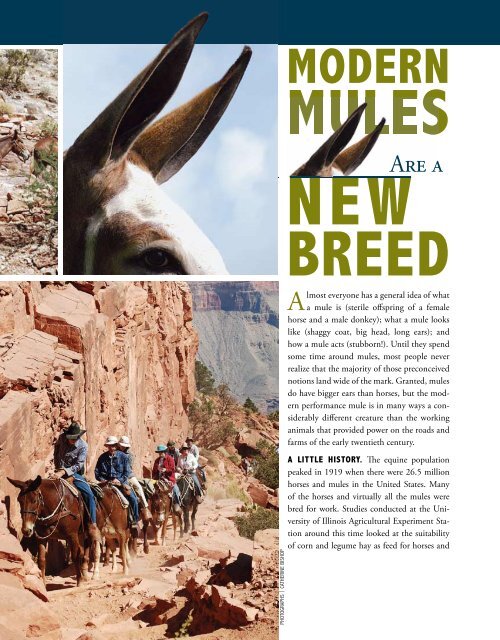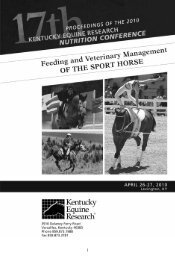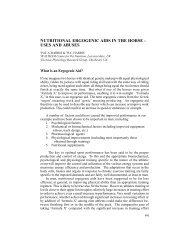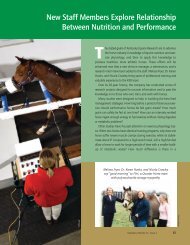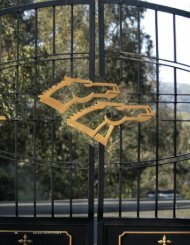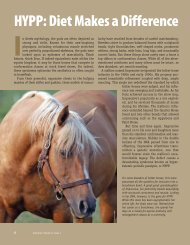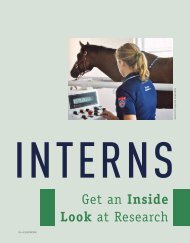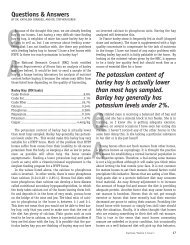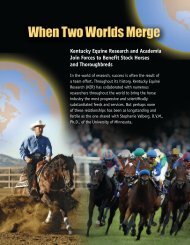Modern Mules are a New Breed - Kentucky Equine Research
Modern Mules are a New Breed - Kentucky Equine Research
Modern Mules are a New Breed - Kentucky Equine Research
You also want an ePaper? Increase the reach of your titles
YUMPU automatically turns print PDFs into web optimized ePapers that Google loves.
PHOTOGRAPHS | CATHERINE BISHOPMODERNMULESNEWBREEDAlmost everyone has a general idea of whata mule is (sterile offspring of a femalehorse and a male donkey); what a mule lookslike (shaggy coat, big head, long ears); andhow a mule acts (stubborn!). Until they spendsome time around mules, most people neverrealize that the majority of those preconceivednotions land wide of the mark. Granted, mulesdo have bigger ears than horses, but the modernperformance mule is in many ways a considerablydifferent creature than the workinganimals that provided power on the roads andfarms of the early twentieth century.NEW ARE AA LITTLE HISTORY. The equine populationpeaked in 1919 when there were 26.5 millionhorses and mules in the United States. Manyof the horses and virtually all the mules werebred for work. Studies conducted at the Universityof Illinois Agricultural Experiment Stationaround this time looked at the suitabilityof corn and legume hay as feed for horses and
PHOTOGRAPH | MARK LLEWELLYNPHOTOGRAPH | CATHERINE BISHOPClockwise from left: At GrandCanyon National Park, sturdymules carry tourists into themile-deep chasm. Passengersspend the night in comfortablecabins before climbing back intothe saddle for the trek out.Unlike the plainer models ofyesteryear, today's donkeysand mules come in a rangeof sizes and colors. "Donkey"and "burro" <strong>are</strong> interchangableterms for these long-e<strong>are</strong>dmembers of the equine family.<strong>Mules</strong> <strong>are</strong> thought to be more"fuel efficient" than horses, andmany <strong>are</strong> easy keepers. Keepingmules in optimal body conditioncan be a challenge.Food, beverages, and othersupplies travel in and out of theGrand Canyon on muleback. TheIndian village of Supai at thebottom of the canyon is the onlyplace where the United StatesPostal Service delivers mailexclusively by mule power.mules working on farms. The research reportpublished in 1922 indicated that the mules andhorses were fed the same ration—essentially allthey would eat!—and that the mules weighedapproximately 1,350 pounds each. Working inteams, they tilled fields or pulled freight wagonsfor eight hours a day, traveling more than1,300 miles during one 140-day study period.Times have changed dramatically, and virtuallyno mules work at this level of exertion in thetwenty-first century.THE UPDATED ANIMAL. Today’s long-ears <strong>are</strong>sleek, slick, and stylish, and they can do a lotmore than just pull a plow. Rough coats andplain heads have been replaced by a more refinedlook, and owners claim that a little empathyand finesse can all but eliminate thatlegendary stubborn streak. Mule shows routinelyoffer halter classes where the animals <strong>are</strong>judged on conformation; driving classes; gameclasses such as barrel racing, pole bending, andkeyhole race; and performance classes includingjumping, dressage, calf roping, and ranchskills. <strong>Mules</strong> <strong>are</strong> also entered in parades, riddenon trails, sought out as endurance race mounts,used in field trials, and fox-hunted. And, ofcourse, some working mules still have “dayjobs” in agriculture, logging, and packing.NEW USES, NEW PROBLEMS. When muleswere chiefly working animals produced by draftm<strong>are</strong>s and draft-type jacks, most work was doneat a walk or trot without many abrupt turns. Inmore recent years mules have moved into performance,showing, and recreational pastimes,and breeders have favored saddle-type m<strong>are</strong>sand smaller, more refined jacks. This change hasproduced a different type of mule that, unfortunately,brings a predisposition to reduced soundness.Pursuits like roping, barrel racing, driving,cutting, and racing require training that maylead to the same injuries and lamenesses seen inhorses. Because mules and donkeys tend to haveEQUINEWS MODERN MULES ARE A NEW BREED 15
A formerly wild burro adoptedfrom the Bureau of LandManagement, Romeo has madethe transition to family pet andshow-ring star. Despite hishandler's whispered instructions,Romeo had his own ideas abouthow to complete the showmanshippattern.a high tolerance to pain, an owner may not detectdiscomfort or lameness until it is advanced,so c<strong>are</strong> must be taken not to ask too much of ayoung or inexperienced animal.FEEDING DONKEYS AND MULES. Not everythingabout the modern mule is a direct parallelto its shorter-e<strong>are</strong>d cousin, and nutritionalmanagement is one of the major differences betweenmules and horses. <strong>Mules</strong> tend to be muchmore efficient in balancing“energy in” and“energy out,” a traitborrowed from theirdonkey ancestors. Ata recent conference ofthe American Associationor <strong>Equine</strong> Practitioners,Dr. SuzanneBurnham of BurnhamVeterinary Hospital inGraham, Texas talkedabout feeding donkeys.“Donkeys havevery different nutrient requirements from ahorse. A normal ration for a horse will makea donkey obese, possibly cause him to founder,and may result in decreased fertility,” shewarned.Though generally much larger than donkeys,mules may also require a restricted diet. Dr.Kathleen Crandell, a nutritionist for <strong>Kentucky</strong><strong>Equine</strong> <strong>Research</strong> (KER), agreed that mules <strong>are</strong>generally fed like horses, only not as much.She advised that many mules get along wellon pasture or hay, with little need for grain ormanufactured feed products. “But just as withhorses, you have to feed each one as an individual,”she said. “I had a 16-hand mule that was <strong>are</strong>tired Master of Foxhounds mount. This mulewas out of a Thoroughbred m<strong>are</strong> and tended tobe a little on the thin side, especially as he gotolder. I had to give him some grain to keep himin good shape.”She suggested that mule owners keep an eye onthe condition of their animals, weighing themor using a weight tape on a regular scheduleand adding or reducing intake as necessary tokeep them in the desired condition. Unless amule or donkey is doing quite a bit of work,it might need to have grazing time reducedconsiderably to avoid becoming obese. Dailyuse of a drylot or grazing muzzle can allow theanimal to exercise in a pasture without gainingtoo much weight.Lakin Milling, a KER Team Member in Arizona,manufactures a number of equine feeds,two of which have found particular favor withmule owners. Tracy Johnson, a marketing representativefor Lakin, explained that manymules get along well on Lakin Lite. This feed isa forage-based product made chiefly of groundalfalfa and Bermuda hay fortified with a fullcomplement of vitamins and minerals. Milledas large pellets, Lakin Lite contains just enoughmolasses to prevent breakage and fines. It isdesigned to provide or supplement the forageportion of the ration without the extra caloriescontained in grain-based feeds. Idle and lightlyworked mules do well on this product.Lakin manager Bob Giacomo said that thecompany’s Equidyne Complete is the bestchoice for mules performing strenuous exercise.This feed contains ground alfalfa hay,molasses, and vitamin/mineral fortification. Tofuel the demands of hard work, Equidyne alsocontains 15% cracked corn, a level of inclusionthat provides energy while minimizing the riskof laminitis and other metabolic disorders.16 EQUINEWS MODERN MULES ARE A NEW BREED
A laid-back temperamentmakes this donkey asuitable mount for heryoung rider. The tuft-e<strong>are</strong>dshow trim emphasizesPetunia's finest feature.TOUGH TRAILS. Among mules that thrive onEquidyne, those with the highest public profilebelong to the outfitters who lead mule trainsin Grand Canyon National Park. These large,muscular mules carry riders, luggage, food, andsupplies from the canyon’s rim down to PhantomRanch, where tourists can spend the nightin spacious cabins before climbing back ontotheir sturdy steeds the next morning for the trekout. The mules walk seven miles of trail on eachleg of the trip, which doesn’t sound like very farto go until you figure in the vertical mile they<strong>are</strong> traversing at the same time. Do the math:That’s one foot of rise for every seven feet traveledhorizontally. For the most part, the mulesmake it look pretty easy. Must be the feed!THEY’RE OFF! Another pastime involvingmules is racing. The circuit includes races at anumber of county fairs in California and otherwestern states. Race distances range from 220to 350 yards. Possibly because purses for thewinners top out at only about $5000 per race,fewer than 100 mules <strong>are</strong> in serious training,according to the American Mule Racing Association.Extra attention was focused on muleracing in the last few years when the world’sfirst cloned equines, Idaho Gem and IdahoStar, made their initial race starts. Producedin a University of Idaho project in 2003, theycarry identical DNA taken from a 45-day-oldmule fetus. The clones have the same p<strong>are</strong>nts,a Quarter Horse m<strong>are</strong> named Mesmerizer anda donkey jack known as Coalee McGee, thatproduced Taz, a champion racing mule. WhileIdaho Gem and Idaho Star didn’t visit the winner’scircle in their first starts, they have finishedrespectably in subsequent races.SHOW TIME. At a recent mule show held nearKER’s location in central <strong>Kentucky</strong>, exhibitorsturned out with animalsof various sizes,colors, and ancestry. Atall, fine-boned whitemule with a brownspot below one eye wasout of a Thoroughbredm<strong>are</strong>; a dapple-graymule boasted QuarterHorse genes. A gaited baymule took home the championshipribbon in the halterclasses. Two mules sportingWestern tack were pressed intoservice to round up a wayward calf at the f<strong>are</strong>nd of the fairgrounds. Multicolored donkeyPetunia, a kid-safe mount despite questionablesteering, carried her nine-year-old ownersedately around the fairgrounds. Romeo, a22-year-old burro adopted from the Bureauof Land Management, patiently endured tugsand pushes as his youthful handler practiced ashowmanship pattern. Judge Ron Thompson,one hand on the youngster’s shoulder and theother hand guiding the burro, calmly advised,“Don’t lose your temper. Just show him whatyou want him to do.” P<strong>are</strong>nts and family membersadjusted tack, called out encouragement,and were generous with their applause.Joe Penn, president of the 100-member <strong>Kentucky</strong>Mule and Donkey Association, explainedthat the show was part of the North AmericanSaddle Mule Association (NASMA) circuit,and riders were earning points toward year-endtotals and awards. There <strong>are</strong> mule and donkeyassociations in almost every state, and manycountries have similar organizations to bringmule enthusiasts together. With their versatilityand long-e<strong>are</strong>d charm, mules just may betoday’s equine “new wave.”EQUINEWS MODERN MULES ARE A NEW BREED 17


